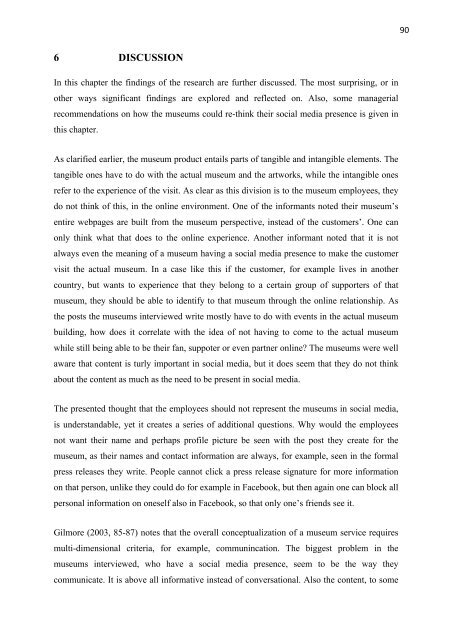Is there more to it than posting a status update?
Is there more to it than posting a status update?
Is there more to it than posting a status update?
Create successful ePaper yourself
Turn your PDF publications into a flip-book with our unique Google optimized e-Paper software.
6 DISCUSSION<br />
In this chapter the findings of the research are further discussed. The most surprising, or in<br />
other ways significant findings are explored and reflected on. Also, some managerial<br />
recommendations on how the museums could re-think their social media presence is given in<br />
this chapter.<br />
As clarified earlier, the museum product entails parts of tangible and intangible elements. The<br />
tangible ones have <strong>to</strong> do w<strong>it</strong>h the actual museum and the artworks, while the intangible ones<br />
refer <strong>to</strong> the experience of the vis<strong>it</strong>. As clear as this division is <strong>to</strong> the museum employees, they<br />
do not think of this, in the online environment. One of the informants noted their museum’s<br />
entire webpages are built from the museum perspective, instead of the cus<strong>to</strong>mers’. One can<br />
only think what that does <strong>to</strong> the online experience. Another informant noted that <strong>it</strong> is not<br />
always even the meaning of a museum having a social media presence <strong>to</strong> make the cus<strong>to</strong>mer<br />
vis<strong>it</strong> the actual museum. In a case like this if the cus<strong>to</strong>mer, for example lives in another<br />
country, but wants <strong>to</strong> experience that they belong <strong>to</strong> a certain group of supporters of that<br />
museum, they should be able <strong>to</strong> identify <strong>to</strong> that museum through the online relationship. As<br />
the posts the museums interviewed wr<strong>it</strong>e mostly have <strong>to</strong> do w<strong>it</strong>h events in the actual museum<br />
building, how does <strong>it</strong> correlate w<strong>it</strong>h the idea of not having <strong>to</strong> come <strong>to</strong> the actual museum<br />
while still being able <strong>to</strong> be their fan, suppoter or even partner online? The museums were well<br />
aware that content is turly important in social media, but <strong>it</strong> does seem that they do not think<br />
about the content as much as the need <strong>to</strong> be present in social media.<br />
The presented thought that the employees should not represent the museums in social media,<br />
is understandable, yet <strong>it</strong> creates a series of add<strong>it</strong>ional questions. Why would the employees<br />
not want their name and perhaps profile picture be seen w<strong>it</strong>h the post they create for the<br />
museum, as their names and contact information are always, for example, seen in the formal<br />
press releases they wr<strong>it</strong>e. People cannot click a press release signature for <strong>more</strong> information<br />
on that person, unlike they could do for example in Facebook, but then again one can block all<br />
personal information on oneself also in Facebook, so that only one’s friends see <strong>it</strong>.<br />
Gil<strong>more</strong> (2003, 85-87) notes that the overall conceptualization of a museum service requires<br />
multi-dimensional cr<strong>it</strong>eria, for example, communincation. The biggest problem in the<br />
museums interviewed, who have a social media presence, seem <strong>to</strong> be the way they<br />
communicate. It is above all informative instead of conversational. Also the content, <strong>to</strong> some<br />
90















